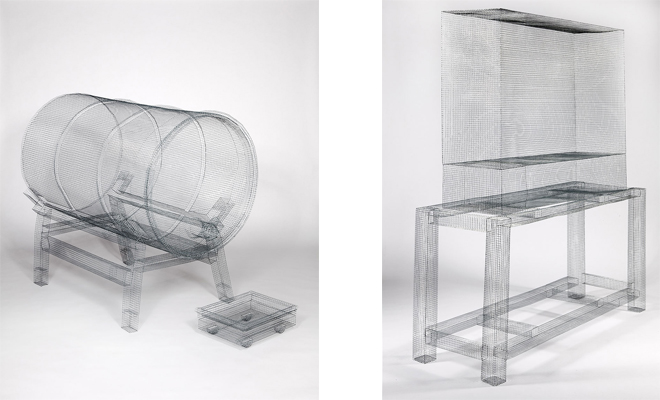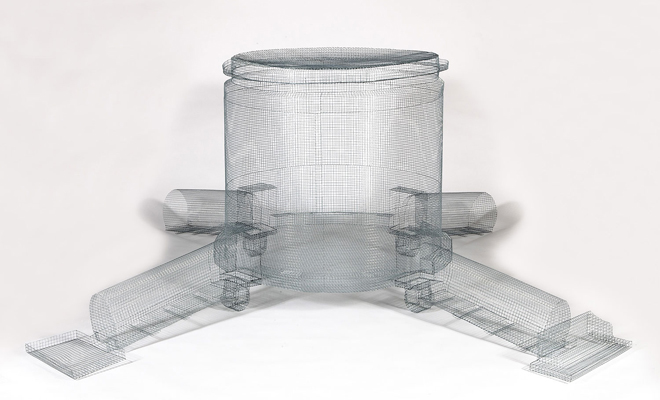Last Call: Brian St. Cyr at the Acadiana Center for the Arts

Brian St. Cyr, I Love My Father and He Loves Me (details left and right), 2013. Four-part installation of woven hardware cloth sculpture. Courtesy the artist.
Editor's Note
It’s the last weekend to catch Brian St. Cyr's “A Whiter Trash of Mondrian” at the Acadiana Center for the Arts. Before it's gone, Reggie Rodrigue checks in from Lafayette to review.
In The Poetics of Space (1958), philosopher Gaston Bachelard writes, “The exterior spectacle helps intimate grandeur unfold.” In essence, one’s memories, thoughts, and emotions are triggered by the exterior world. This idea is central to Brian St. Cyr’s exhibition "A Whiter Trash of Mondrian " at the Acadiana Center for the Arts in Lafayette.
St. Cyr’s artist statement acts as a guide—a rebus that includes the front cover of Bachelard’s book, a painting by Piet Mondrian, Cletus from The Simpsons, rabbits, a time clock, and bags of blood—helping viewers uncover the personal and social meanings in his delicate sculptures and drawings.
As a sculptor, St. Cyr’s main concern is the way that an object or a group of objects can articulate space and frame experience. Here, the artist’s use of wire and mesh denies a materialist reading, making the space and experience decidedly Platonic and contemplative. Transparent and linear, St. Cyr’s sculptures formally allude to things in the exterior world. He calls his sculptures "cages," and they act as vessels for the concept of a physical object and the meaning contained within. Alternatively, one could think of them as three-dimensional blueprints or models. With all of the crisscrossing wire and mesh forming grids, St. Cyr appeals to the ghost of Piet Mondrian, the high priest of Euclidean ecstasy and one of the architects of modernism. The irony is that these lofty references to culture are used to articulate forms associated with manual labor, animal husbandry, and childhood. This is absurdly personified by Cletus, the Slack-Jawed Yokel (the epitome of “white trash” in The Simpsons universe) in St. Cyr’s artist’s statement.
Occupying most of the Center’s Side Gallery floor space, the sculptural quartet, I Love My Father and He Loves Me, 2013, consists of what appear to be representations of a rabbit cage on a stand, a livestock-feeding silo, a barrel with a spigot atop two saw horses, and what could possibly be a table saw with saw horses. The juxtaposition between what they are representing (mundane tools) and what they actually are (meticulously crafted wire sculptures) points to their additional function as symbols. From the grouping’s title, one can deduce that the individual sculptures are representations of St. Cyr’s father’s tools. However, they are more than that, standing in for such abstract things as familial love, filial responsibility, occupational pride, and the passing of tradition.
Among these and other sculptures, St. Cyr includes a selection of drawings and prints. Here one enters shallow white expanses occupied by lines both eloquent and erratic, delineating mounds of record players, phantasmagoric Mickey Mouses, hybrid machines with animalistic features, and praying mantises. Like scribbles in an adolescent’s notebook, many of the machine-animals and mantises belch quotations such as TOO MUCH!, I AM MASSIVE!, and FOUR ON THE FLOOR! St. Cyr’s comic sensibilities and his fascination with the macabre (both of which are latent in his sculptures) are fully expressed in his drawings and prints.
St. Cyr has said that he often chooses mundane materials and subjects because he is interested in what unexpected forms and meanings he can tease out of them. With his current exhibition, he has most assuredly succeeded, collapsing modernism into pop culture and marrying object conceptualism with personal recollections. If one is willing to enter into it with an open and searching intellect, St. Cyr’s exhibition can be enjoyed as his rebus suggests—as a perverse yet sacred puzzle and a space for discovery.

Brian St. Cyr, I Love My Father and He Loves Me (detail), 2013. Four-part installation of woven hardware cloth sculpture. Courtesy the artist.
Editor's Note
Brian St. Cyr's “A Whiter Trash of Mondrian” on view until August 31 at the Acadiana Center for the Arts (101 West Vermilion Street) in Lafayette.



